Health Variation 4
VerifiedAdded on 2023/04/08
|8
|1671
|91
AI Summary
This document discusses urinary tract infections, including their classification, pathogenesis, and clinical manifestations. It also explores the importance of arterial blood gas analysis in diagnosing and managing patients' oxygenation status and acid-base balance. The interpretation of ABG results is provided, along with recommendations to eliminate the unnecessary placement of indwelling catheters. The document emphasizes the need for educational interventions and the implementation of catheter placement restriction protocols to reduce catheter-associated UTIs.
Contribute Materials
Your contribution can guide someone’s learning journey. Share your
documents today.

Running head: HEALTH VARIATION 4 1
Health Variation 4
Student Name
Institutional Affiliation
Health Variation 4
Student Name
Institutional Affiliation
Secure Best Marks with AI Grader
Need help grading? Try our AI Grader for instant feedback on your assignments.
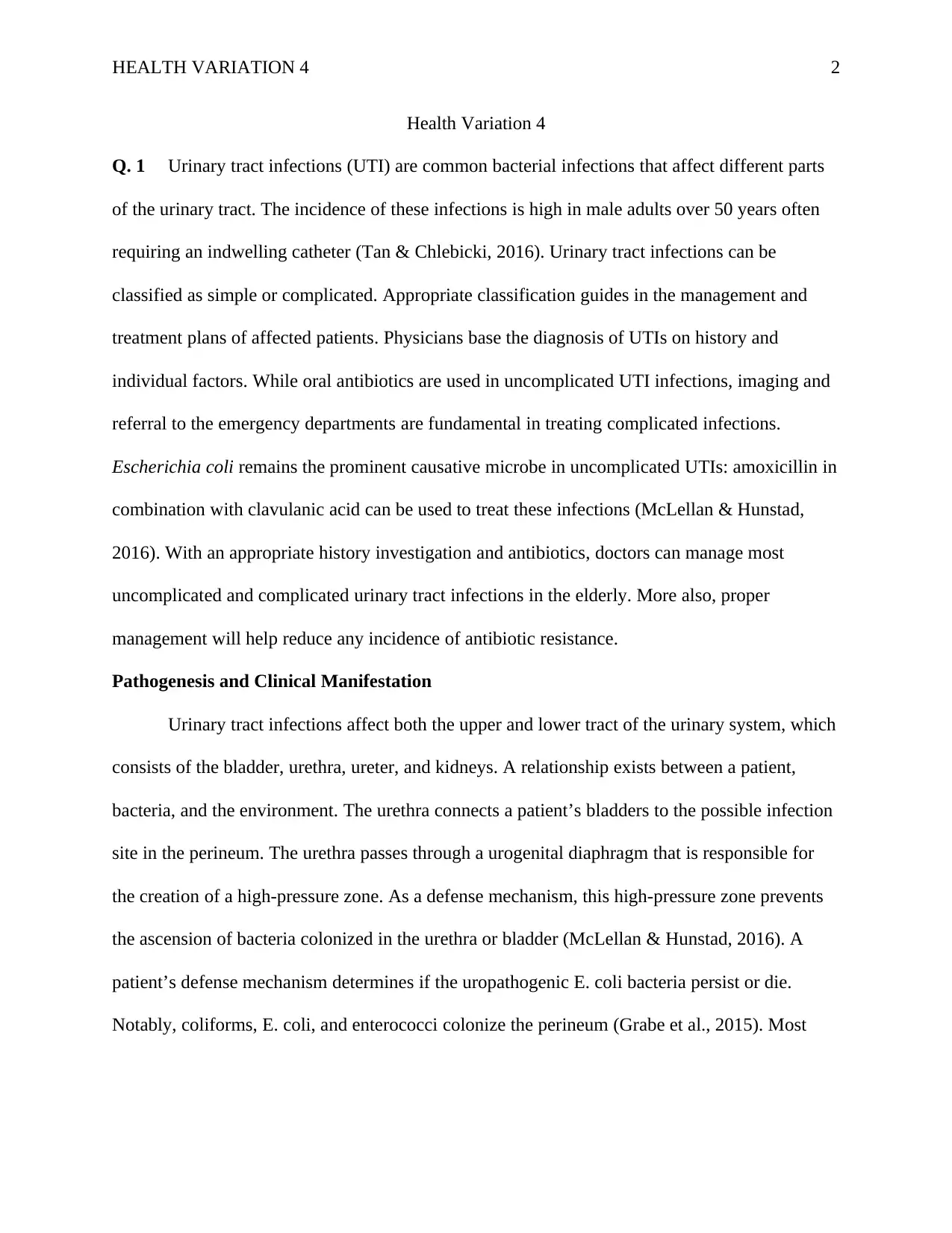
HEALTH VARIATION 4 2
Health Variation 4
Q. 1 Urinary tract infections (UTI) are common bacterial infections that affect different parts
of the urinary tract. The incidence of these infections is high in male adults over 50 years often
requiring an indwelling catheter (Tan & Chlebicki, 2016). Urinary tract infections can be
classified as simple or complicated. Appropriate classification guides in the management and
treatment plans of affected patients. Physicians base the diagnosis of UTIs on history and
individual factors. While oral antibiotics are used in uncomplicated UTI infections, imaging and
referral to the emergency departments are fundamental in treating complicated infections.
Escherichia coli remains the prominent causative microbe in uncomplicated UTIs: amoxicillin in
combination with clavulanic acid can be used to treat these infections (McLellan & Hunstad,
2016). With an appropriate history investigation and antibiotics, doctors can manage most
uncomplicated and complicated urinary tract infections in the elderly. More also, proper
management will help reduce any incidence of antibiotic resistance.
Pathogenesis and Clinical Manifestation
Urinary tract infections affect both the upper and lower tract of the urinary system, which
consists of the bladder, urethra, ureter, and kidneys. A relationship exists between a patient,
bacteria, and the environment. The urethra connects a patient’s bladders to the possible infection
site in the perineum. The urethra passes through a urogenital diaphragm that is responsible for
the creation of a high-pressure zone. As a defense mechanism, this high-pressure zone prevents
the ascension of bacteria colonized in the urethra or bladder (McLellan & Hunstad, 2016). A
patient’s defense mechanism determines if the uropathogenic E. coli bacteria persist or die.
Notably, coliforms, E. coli, and enterococci colonize the perineum (Grabe et al., 2015). Most
Health Variation 4
Q. 1 Urinary tract infections (UTI) are common bacterial infections that affect different parts
of the urinary tract. The incidence of these infections is high in male adults over 50 years often
requiring an indwelling catheter (Tan & Chlebicki, 2016). Urinary tract infections can be
classified as simple or complicated. Appropriate classification guides in the management and
treatment plans of affected patients. Physicians base the diagnosis of UTIs on history and
individual factors. While oral antibiotics are used in uncomplicated UTI infections, imaging and
referral to the emergency departments are fundamental in treating complicated infections.
Escherichia coli remains the prominent causative microbe in uncomplicated UTIs: amoxicillin in
combination with clavulanic acid can be used to treat these infections (McLellan & Hunstad,
2016). With an appropriate history investigation and antibiotics, doctors can manage most
uncomplicated and complicated urinary tract infections in the elderly. More also, proper
management will help reduce any incidence of antibiotic resistance.
Pathogenesis and Clinical Manifestation
Urinary tract infections affect both the upper and lower tract of the urinary system, which
consists of the bladder, urethra, ureter, and kidneys. A relationship exists between a patient,
bacteria, and the environment. The urethra connects a patient’s bladders to the possible infection
site in the perineum. The urethra passes through a urogenital diaphragm that is responsible for
the creation of a high-pressure zone. As a defense mechanism, this high-pressure zone prevents
the ascension of bacteria colonized in the urethra or bladder (McLellan & Hunstad, 2016). A
patient’s defense mechanism determines if the uropathogenic E. coli bacteria persist or die.
Notably, coliforms, E. coli, and enterococci colonize the perineum (Grabe et al., 2015). Most
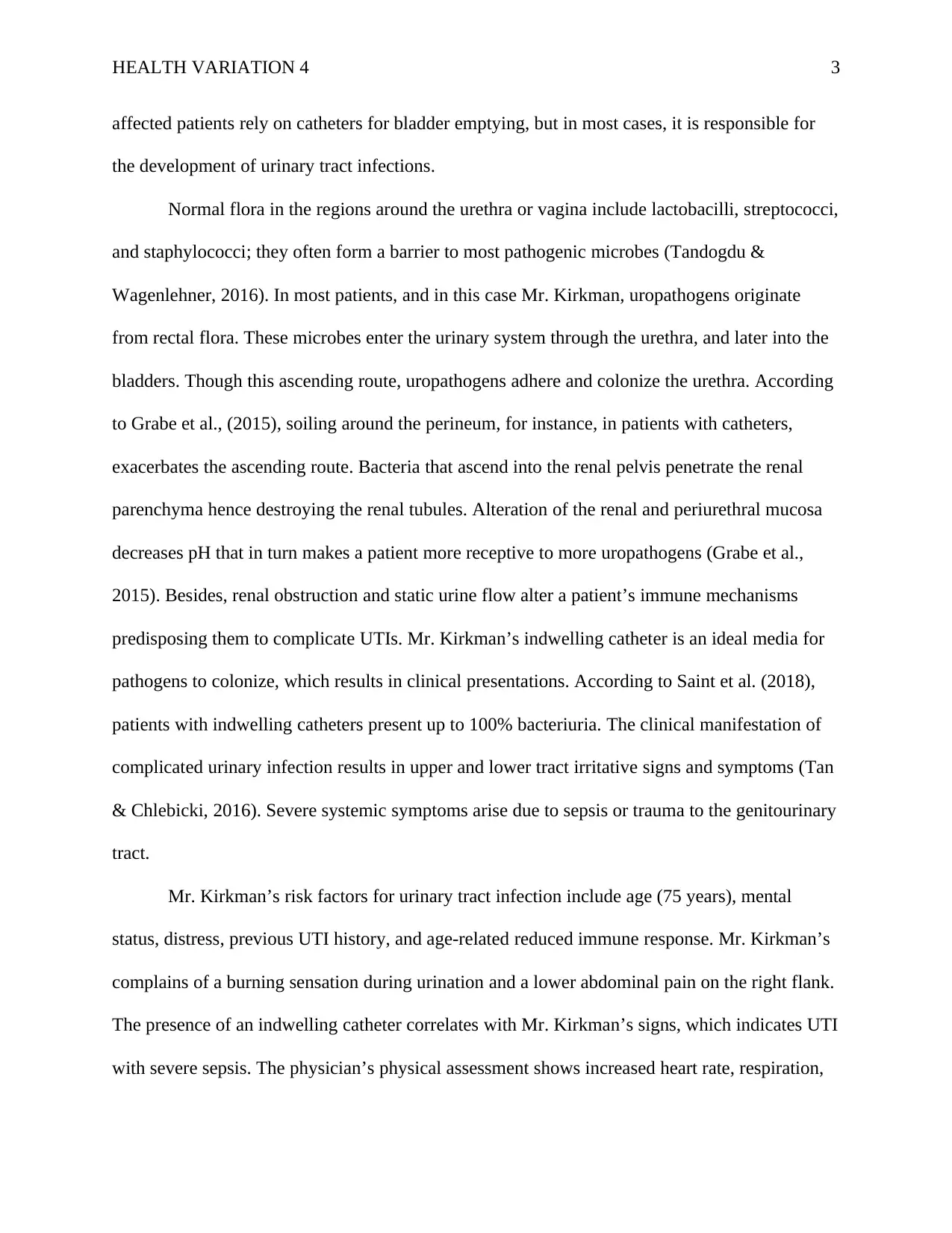
HEALTH VARIATION 4 3
affected patients rely on catheters for bladder emptying, but in most cases, it is responsible for
the development of urinary tract infections.
Normal flora in the regions around the urethra or vagina include lactobacilli, streptococci,
and staphylococci; they often form a barrier to most pathogenic microbes (Tandogdu &
Wagenlehner, 2016). In most patients, and in this case Mr. Kirkman, uropathogens originate
from rectal flora. These microbes enter the urinary system through the urethra, and later into the
bladders. Though this ascending route, uropathogens adhere and colonize the urethra. According
to Grabe et al., (2015), soiling around the perineum, for instance, in patients with catheters,
exacerbates the ascending route. Bacteria that ascend into the renal pelvis penetrate the renal
parenchyma hence destroying the renal tubules. Alteration of the renal and periurethral mucosa
decreases pH that in turn makes a patient more receptive to more uropathogens (Grabe et al.,
2015). Besides, renal obstruction and static urine flow alter a patient’s immune mechanisms
predisposing them to complicate UTIs. Mr. Kirkman’s indwelling catheter is an ideal media for
pathogens to colonize, which results in clinical presentations. According to Saint et al. (2018),
patients with indwelling catheters present up to 100% bacteriuria. The clinical manifestation of
complicated urinary infection results in upper and lower tract irritative signs and symptoms (Tan
& Chlebicki, 2016). Severe systemic symptoms arise due to sepsis or trauma to the genitourinary
tract.
Mr. Kirkman’s risk factors for urinary tract infection include age (75 years), mental
status, distress, previous UTI history, and age-related reduced immune response. Mr. Kirkman’s
complains of a burning sensation during urination and a lower abdominal pain on the right flank.
The presence of an indwelling catheter correlates with Mr. Kirkman’s signs, which indicates UTI
with severe sepsis. The physician’s physical assessment shows increased heart rate, respiration,
affected patients rely on catheters for bladder emptying, but in most cases, it is responsible for
the development of urinary tract infections.
Normal flora in the regions around the urethra or vagina include lactobacilli, streptococci,
and staphylococci; they often form a barrier to most pathogenic microbes (Tandogdu &
Wagenlehner, 2016). In most patients, and in this case Mr. Kirkman, uropathogens originate
from rectal flora. These microbes enter the urinary system through the urethra, and later into the
bladders. Though this ascending route, uropathogens adhere and colonize the urethra. According
to Grabe et al., (2015), soiling around the perineum, for instance, in patients with catheters,
exacerbates the ascending route. Bacteria that ascend into the renal pelvis penetrate the renal
parenchyma hence destroying the renal tubules. Alteration of the renal and periurethral mucosa
decreases pH that in turn makes a patient more receptive to more uropathogens (Grabe et al.,
2015). Besides, renal obstruction and static urine flow alter a patient’s immune mechanisms
predisposing them to complicate UTIs. Mr. Kirkman’s indwelling catheter is an ideal media for
pathogens to colonize, which results in clinical presentations. According to Saint et al. (2018),
patients with indwelling catheters present up to 100% bacteriuria. The clinical manifestation of
complicated urinary infection results in upper and lower tract irritative signs and symptoms (Tan
& Chlebicki, 2016). Severe systemic symptoms arise due to sepsis or trauma to the genitourinary
tract.
Mr. Kirkman’s risk factors for urinary tract infection include age (75 years), mental
status, distress, previous UTI history, and age-related reduced immune response. Mr. Kirkman’s
complains of a burning sensation during urination and a lower abdominal pain on the right flank.
The presence of an indwelling catheter correlates with Mr. Kirkman’s signs, which indicates UTI
with severe sepsis. The physician’s physical assessment shows increased heart rate, respiration,
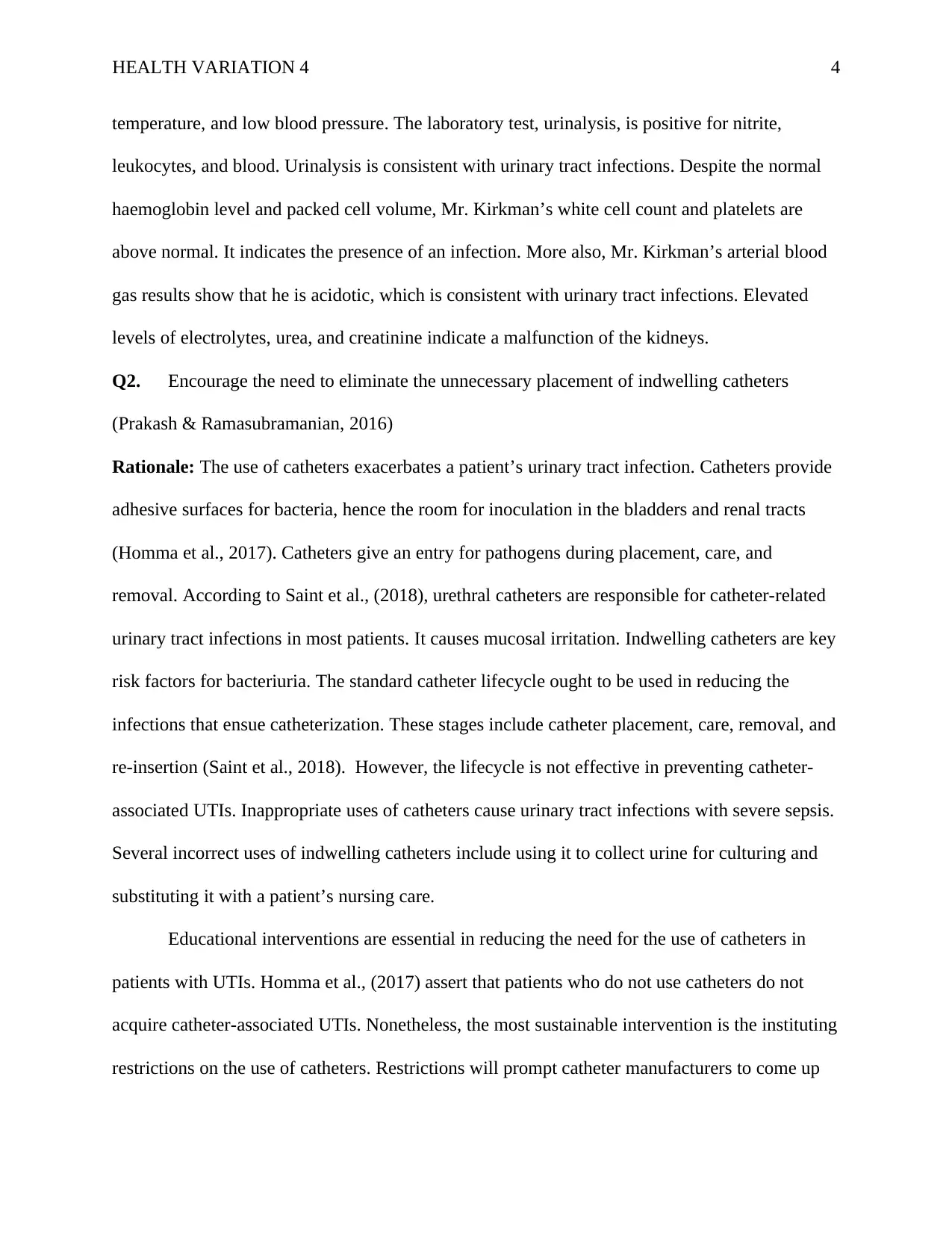
HEALTH VARIATION 4 4
temperature, and low blood pressure. The laboratory test, urinalysis, is positive for nitrite,
leukocytes, and blood. Urinalysis is consistent with urinary tract infections. Despite the normal
haemoglobin level and packed cell volume, Mr. Kirkman’s white cell count and platelets are
above normal. It indicates the presence of an infection. More also, Mr. Kirkman’s arterial blood
gas results show that he is acidotic, which is consistent with urinary tract infections. Elevated
levels of electrolytes, urea, and creatinine indicate a malfunction of the kidneys.
Q2. Encourage the need to eliminate the unnecessary placement of indwelling catheters
(Prakash & Ramasubramanian, 2016)
Rationale: The use of catheters exacerbates a patient’s urinary tract infection. Catheters provide
adhesive surfaces for bacteria, hence the room for inoculation in the bladders and renal tracts
(Homma et al., 2017). Catheters give an entry for pathogens during placement, care, and
removal. According to Saint et al., (2018), urethral catheters are responsible for catheter-related
urinary tract infections in most patients. It causes mucosal irritation. Indwelling catheters are key
risk factors for bacteriuria. The standard catheter lifecycle ought to be used in reducing the
infections that ensue catheterization. These stages include catheter placement, care, removal, and
re-insertion (Saint et al., 2018). However, the lifecycle is not effective in preventing catheter-
associated UTIs. Inappropriate uses of catheters cause urinary tract infections with severe sepsis.
Several incorrect uses of indwelling catheters include using it to collect urine for culturing and
substituting it with a patient’s nursing care.
Educational interventions are essential in reducing the need for the use of catheters in
patients with UTIs. Homma et al., (2017) assert that patients who do not use catheters do not
acquire catheter-associated UTIs. Nonetheless, the most sustainable intervention is the instituting
restrictions on the use of catheters. Restrictions will prompt catheter manufacturers to come up
temperature, and low blood pressure. The laboratory test, urinalysis, is positive for nitrite,
leukocytes, and blood. Urinalysis is consistent with urinary tract infections. Despite the normal
haemoglobin level and packed cell volume, Mr. Kirkman’s white cell count and platelets are
above normal. It indicates the presence of an infection. More also, Mr. Kirkman’s arterial blood
gas results show that he is acidotic, which is consistent with urinary tract infections. Elevated
levels of electrolytes, urea, and creatinine indicate a malfunction of the kidneys.
Q2. Encourage the need to eliminate the unnecessary placement of indwelling catheters
(Prakash & Ramasubramanian, 2016)
Rationale: The use of catheters exacerbates a patient’s urinary tract infection. Catheters provide
adhesive surfaces for bacteria, hence the room for inoculation in the bladders and renal tracts
(Homma et al., 2017). Catheters give an entry for pathogens during placement, care, and
removal. According to Saint et al., (2018), urethral catheters are responsible for catheter-related
urinary tract infections in most patients. It causes mucosal irritation. Indwelling catheters are key
risk factors for bacteriuria. The standard catheter lifecycle ought to be used in reducing the
infections that ensue catheterization. These stages include catheter placement, care, removal, and
re-insertion (Saint et al., 2018). However, the lifecycle is not effective in preventing catheter-
associated UTIs. Inappropriate uses of catheters cause urinary tract infections with severe sepsis.
Several incorrect uses of indwelling catheters include using it to collect urine for culturing and
substituting it with a patient’s nursing care.
Educational interventions are essential in reducing the need for the use of catheters in
patients with UTIs. Homma et al., (2017) assert that patients who do not use catheters do not
acquire catheter-associated UTIs. Nonetheless, the most sustainable intervention is the instituting
restrictions on the use of catheters. Restrictions will prompt catheter manufacturers to come up
Secure Best Marks with AI Grader
Need help grading? Try our AI Grader for instant feedback on your assignments.
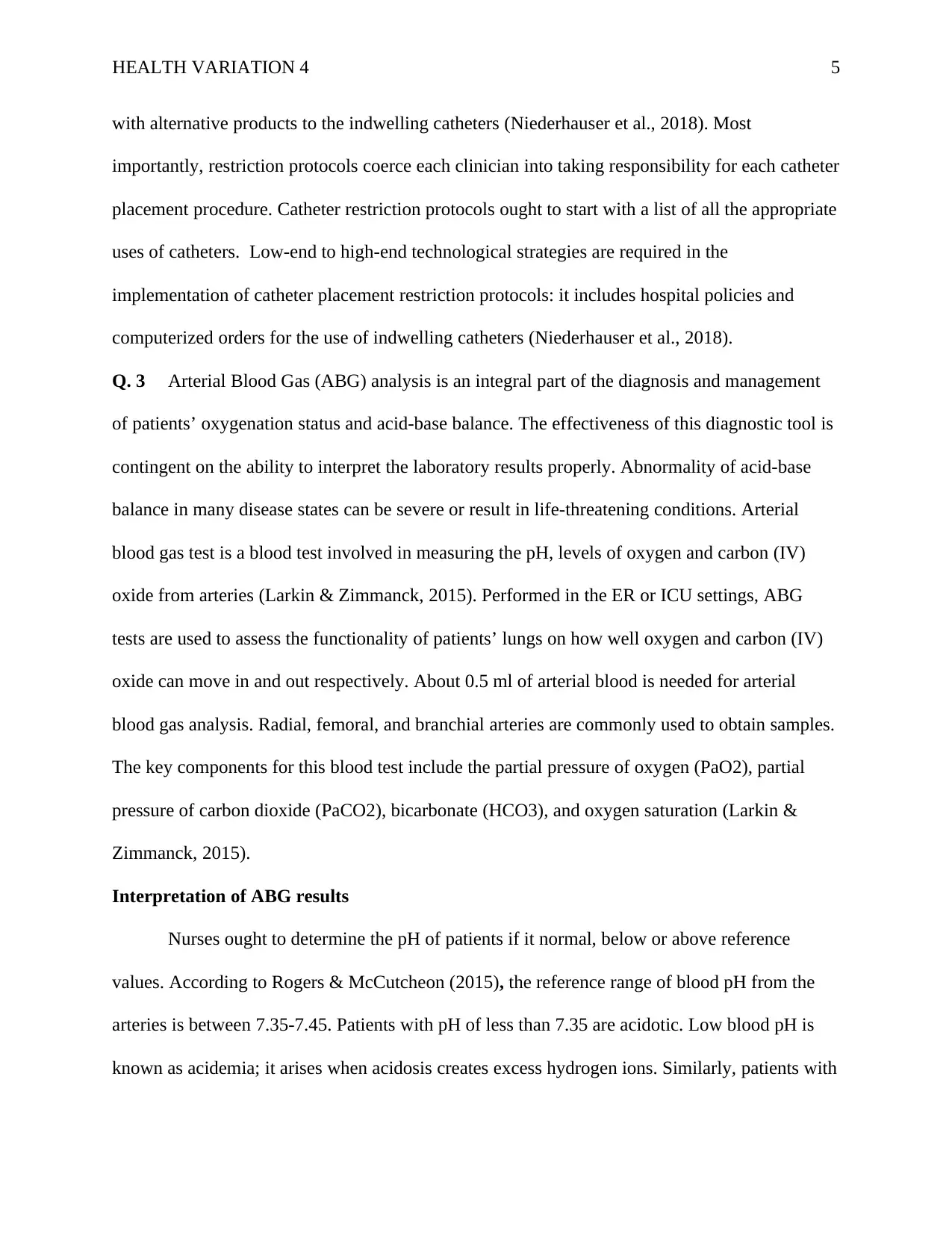
HEALTH VARIATION 4 5
with alternative products to the indwelling catheters (Niederhauser et al., 2018). Most
importantly, restriction protocols coerce each clinician into taking responsibility for each catheter
placement procedure. Catheter restriction protocols ought to start with a list of all the appropriate
uses of catheters. Low-end to high-end technological strategies are required in the
implementation of catheter placement restriction protocols: it includes hospital policies and
computerized orders for the use of indwelling catheters (Niederhauser et al., 2018).
Q. 3 Arterial Blood Gas (ABG) analysis is an integral part of the diagnosis and management
of patients’ oxygenation status and acid-base balance. The effectiveness of this diagnostic tool is
contingent on the ability to interpret the laboratory results properly. Abnormality of acid-base
balance in many disease states can be severe or result in life-threatening conditions. Arterial
blood gas test is a blood test involved in measuring the pH, levels of oxygen and carbon (IV)
oxide from arteries (Larkin & Zimmanck, 2015). Performed in the ER or ICU settings, ABG
tests are used to assess the functionality of patients’ lungs on how well oxygen and carbon (IV)
oxide can move in and out respectively. About 0.5 ml of arterial blood is needed for arterial
blood gas analysis. Radial, femoral, and branchial arteries are commonly used to obtain samples.
The key components for this blood test include the partial pressure of oxygen (PaO2), partial
pressure of carbon dioxide (PaCO2), bicarbonate (HCO3), and oxygen saturation (Larkin &
Zimmanck, 2015).
Interpretation of ABG results
Nurses ought to determine the pH of patients if it normal, below or above reference
values. According to Rogers & McCutcheon (2015), the reference range of blood pH from the
arteries is between 7.35-7.45. Patients with pH of less than 7.35 are acidotic. Low blood pH is
known as acidemia; it arises when acidosis creates excess hydrogen ions. Similarly, patients with
with alternative products to the indwelling catheters (Niederhauser et al., 2018). Most
importantly, restriction protocols coerce each clinician into taking responsibility for each catheter
placement procedure. Catheter restriction protocols ought to start with a list of all the appropriate
uses of catheters. Low-end to high-end technological strategies are required in the
implementation of catheter placement restriction protocols: it includes hospital policies and
computerized orders for the use of indwelling catheters (Niederhauser et al., 2018).
Q. 3 Arterial Blood Gas (ABG) analysis is an integral part of the diagnosis and management
of patients’ oxygenation status and acid-base balance. The effectiveness of this diagnostic tool is
contingent on the ability to interpret the laboratory results properly. Abnormality of acid-base
balance in many disease states can be severe or result in life-threatening conditions. Arterial
blood gas test is a blood test involved in measuring the pH, levels of oxygen and carbon (IV)
oxide from arteries (Larkin & Zimmanck, 2015). Performed in the ER or ICU settings, ABG
tests are used to assess the functionality of patients’ lungs on how well oxygen and carbon (IV)
oxide can move in and out respectively. About 0.5 ml of arterial blood is needed for arterial
blood gas analysis. Radial, femoral, and branchial arteries are commonly used to obtain samples.
The key components for this blood test include the partial pressure of oxygen (PaO2), partial
pressure of carbon dioxide (PaCO2), bicarbonate (HCO3), and oxygen saturation (Larkin &
Zimmanck, 2015).
Interpretation of ABG results
Nurses ought to determine the pH of patients if it normal, below or above reference
values. According to Rogers & McCutcheon (2015), the reference range of blood pH from the
arteries is between 7.35-7.45. Patients with pH of less than 7.35 are acidotic. Low blood pH is
known as acidemia; it arises when acidosis creates excess hydrogen ions. Similarly, patients with
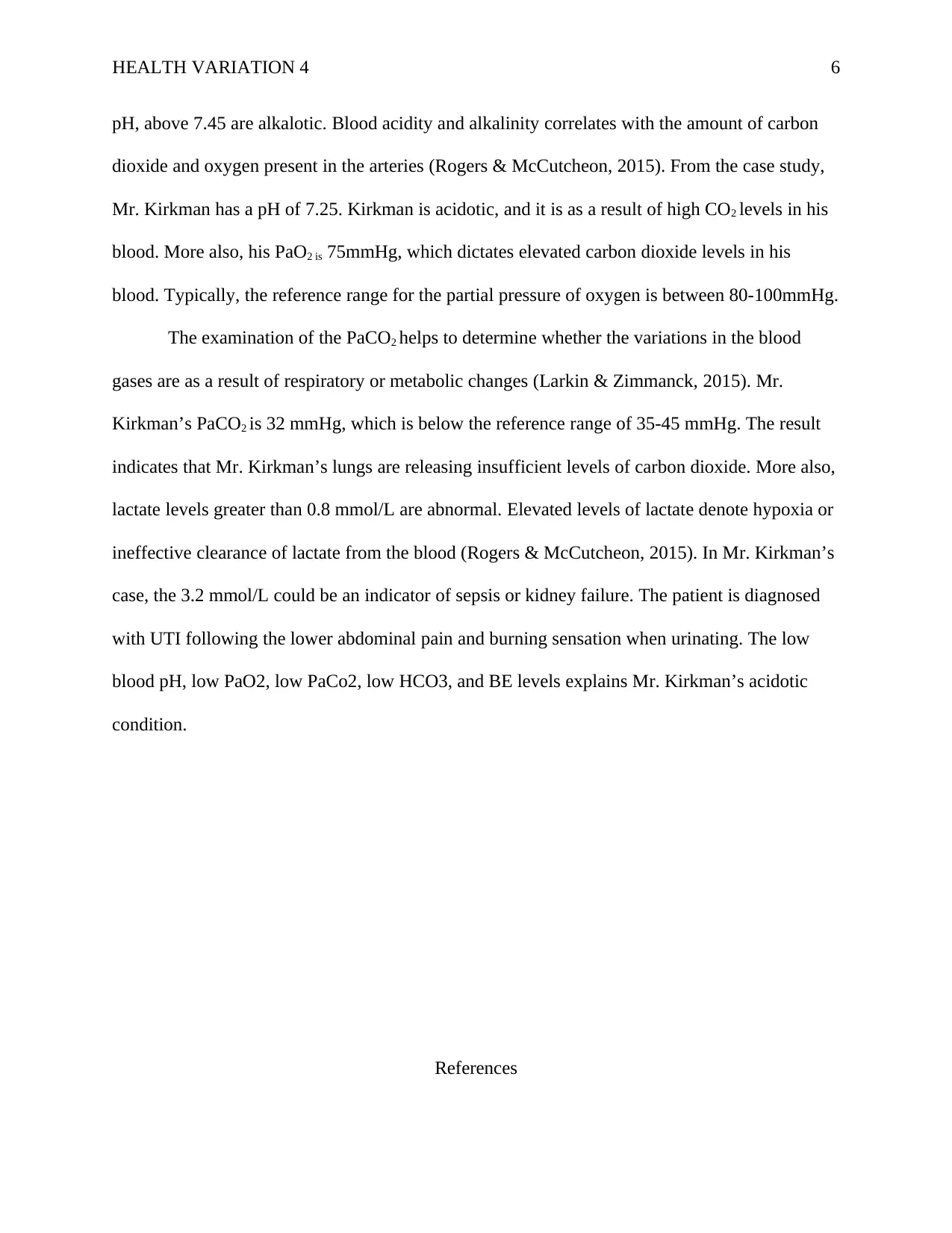
HEALTH VARIATION 4 6
pH, above 7.45 are alkalotic. Blood acidity and alkalinity correlates with the amount of carbon
dioxide and oxygen present in the arteries (Rogers & McCutcheon, 2015). From the case study,
Mr. Kirkman has a pH of 7.25. Kirkman is acidotic, and it is as a result of high CO2 levels in his
blood. More also, his PaO2 is 75mmHg, which dictates elevated carbon dioxide levels in his
blood. Typically, the reference range for the partial pressure of oxygen is between 80-100mmHg.
The examination of the PaCO2 helps to determine whether the variations in the blood
gases are as a result of respiratory or metabolic changes (Larkin & Zimmanck, 2015). Mr.
Kirkman’s PaCO2 is 32 mmHg, which is below the reference range of 35-45 mmHg. The result
indicates that Mr. Kirkman’s lungs are releasing insufficient levels of carbon dioxide. More also,
lactate levels greater than 0.8 mmol/L are abnormal. Elevated levels of lactate denote hypoxia or
ineffective clearance of lactate from the blood (Rogers & McCutcheon, 2015). In Mr. Kirkman’s
case, the 3.2 mmol/L could be an indicator of sepsis or kidney failure. The patient is diagnosed
with UTI following the lower abdominal pain and burning sensation when urinating. The low
blood pH, low PaO2, low PaCo2, low HCO3, and BE levels explains Mr. Kirkman’s acidotic
condition.
References
pH, above 7.45 are alkalotic. Blood acidity and alkalinity correlates with the amount of carbon
dioxide and oxygen present in the arteries (Rogers & McCutcheon, 2015). From the case study,
Mr. Kirkman has a pH of 7.25. Kirkman is acidotic, and it is as a result of high CO2 levels in his
blood. More also, his PaO2 is 75mmHg, which dictates elevated carbon dioxide levels in his
blood. Typically, the reference range for the partial pressure of oxygen is between 80-100mmHg.
The examination of the PaCO2 helps to determine whether the variations in the blood
gases are as a result of respiratory or metabolic changes (Larkin & Zimmanck, 2015). Mr.
Kirkman’s PaCO2 is 32 mmHg, which is below the reference range of 35-45 mmHg. The result
indicates that Mr. Kirkman’s lungs are releasing insufficient levels of carbon dioxide. More also,
lactate levels greater than 0.8 mmol/L are abnormal. Elevated levels of lactate denote hypoxia or
ineffective clearance of lactate from the blood (Rogers & McCutcheon, 2015). In Mr. Kirkman’s
case, the 3.2 mmol/L could be an indicator of sepsis or kidney failure. The patient is diagnosed
with UTI following the lower abdominal pain and burning sensation when urinating. The low
blood pH, low PaO2, low PaCo2, low HCO3, and BE levels explains Mr. Kirkman’s acidotic
condition.
References
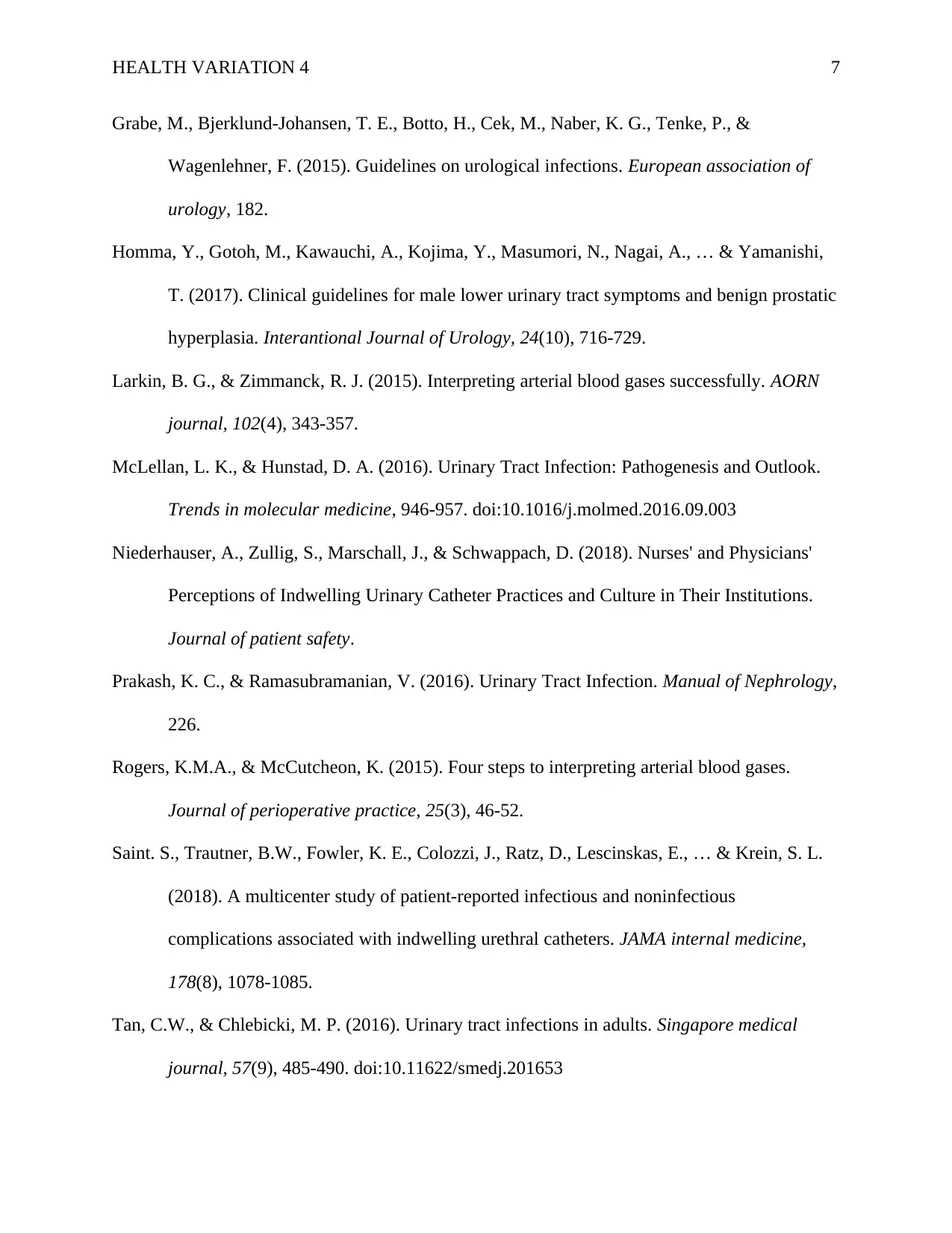
HEALTH VARIATION 4 7
Grabe, M., Bjerklund-Johansen, T. E., Botto, H., Cek, M., Naber, K. G., Tenke, P., &
Wagenlehner, F. (2015). Guidelines on urological infections. European association of
urology, 182.
Homma, Y., Gotoh, M., Kawauchi, A., Kojima, Y., Masumori, N., Nagai, A., … & Yamanishi,
T. (2017). Clinical guidelines for male lower urinary tract symptoms and benign prostatic
hyperplasia. Interantional Journal of Urology, 24(10), 716-729.
Larkin, B. G., & Zimmanck, R. J. (2015). Interpreting arterial blood gases successfully. AORN
journal, 102(4), 343-357.
McLellan, L. K., & Hunstad, D. A. (2016). Urinary Tract Infection: Pathogenesis and Outlook.
Trends in molecular medicine, 946-957. doi:10.1016/j.molmed.2016.09.003
Niederhauser, A., Zullig, S., Marschall, J., & Schwappach, D. (2018). Nurses' and Physicians'
Perceptions of Indwelling Urinary Catheter Practices and Culture in Their Institutions.
Journal of patient safety.
Prakash, K. C., & Ramasubramanian, V. (2016). Urinary Tract Infection. Manual of Nephrology,
226.
Rogers, K.M.A., & McCutcheon, K. (2015). Four steps to interpreting arterial blood gases.
Journal of perioperative practice, 25(3), 46-52.
Saint. S., Trautner, B.W., Fowler, K. E., Colozzi, J., Ratz, D., Lescinskas, E., … & Krein, S. L.
(2018). A multicenter study of patient-reported infectious and noninfectious
complications associated with indwelling urethral catheters. JAMA internal medicine,
178(8), 1078-1085.
Tan, C.W., & Chlebicki, M. P. (2016). Urinary tract infections in adults. Singapore medical
journal, 57(9), 485-490. doi:10.11622/smedj.201653
Grabe, M., Bjerklund-Johansen, T. E., Botto, H., Cek, M., Naber, K. G., Tenke, P., &
Wagenlehner, F. (2015). Guidelines on urological infections. European association of
urology, 182.
Homma, Y., Gotoh, M., Kawauchi, A., Kojima, Y., Masumori, N., Nagai, A., … & Yamanishi,
T. (2017). Clinical guidelines for male lower urinary tract symptoms and benign prostatic
hyperplasia. Interantional Journal of Urology, 24(10), 716-729.
Larkin, B. G., & Zimmanck, R. J. (2015). Interpreting arterial blood gases successfully. AORN
journal, 102(4), 343-357.
McLellan, L. K., & Hunstad, D. A. (2016). Urinary Tract Infection: Pathogenesis and Outlook.
Trends in molecular medicine, 946-957. doi:10.1016/j.molmed.2016.09.003
Niederhauser, A., Zullig, S., Marschall, J., & Schwappach, D. (2018). Nurses' and Physicians'
Perceptions of Indwelling Urinary Catheter Practices and Culture in Their Institutions.
Journal of patient safety.
Prakash, K. C., & Ramasubramanian, V. (2016). Urinary Tract Infection. Manual of Nephrology,
226.
Rogers, K.M.A., & McCutcheon, K. (2015). Four steps to interpreting arterial blood gases.
Journal of perioperative practice, 25(3), 46-52.
Saint. S., Trautner, B.W., Fowler, K. E., Colozzi, J., Ratz, D., Lescinskas, E., … & Krein, S. L.
(2018). A multicenter study of patient-reported infectious and noninfectious
complications associated with indwelling urethral catheters. JAMA internal medicine,
178(8), 1078-1085.
Tan, C.W., & Chlebicki, M. P. (2016). Urinary tract infections in adults. Singapore medical
journal, 57(9), 485-490. doi:10.11622/smedj.201653
Paraphrase This Document
Need a fresh take? Get an instant paraphrase of this document with our AI Paraphraser

HEALTH VARIATION 4 8
Tandogdu, Z., & Wagenlehner, F. M. (2016). Global epidemiology of urinary tract infections.
Current opinion in infectious diseases, 29(1), 73-79.
Tandogdu, Z., & Wagenlehner, F. M. (2016). Global epidemiology of urinary tract infections.
Current opinion in infectious diseases, 29(1), 73-79.
1 out of 8
Related Documents
Your All-in-One AI-Powered Toolkit for Academic Success.
+13062052269
info@desklib.com
Available 24*7 on WhatsApp / Email
![[object Object]](/_next/static/media/star-bottom.7253800d.svg)
Unlock your academic potential
© 2024 | Zucol Services PVT LTD | All rights reserved.





